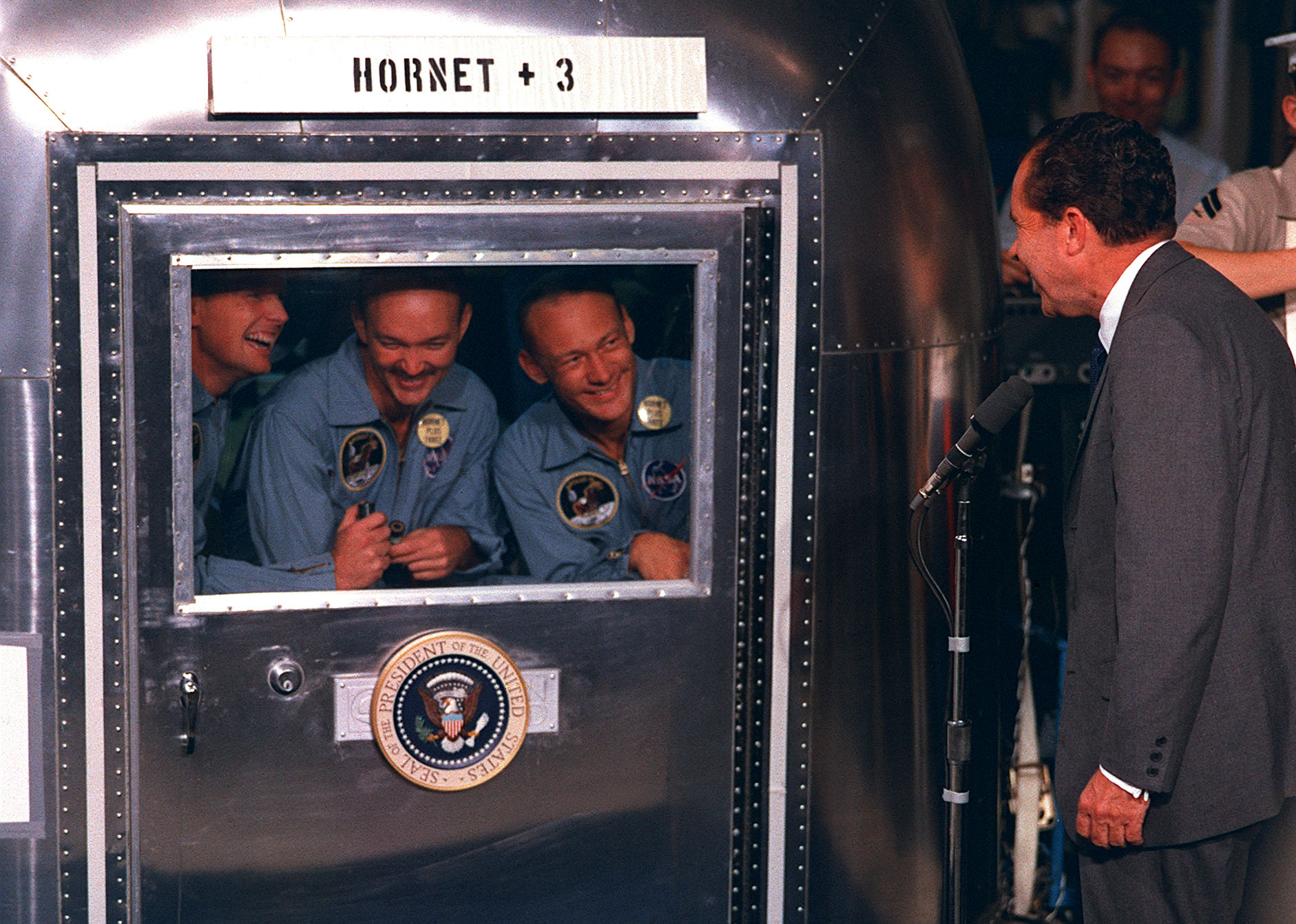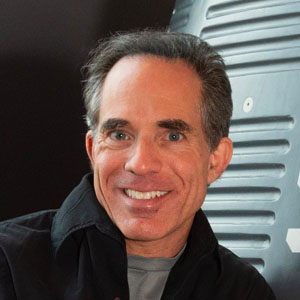Should the Moon Be Quarantined?

The moon and the word "astrobiology" don't often appear in the same sentence — even with a handful of government space agencies and private corporations planning crewed forays to the lunar surface for the first time since NASA's Apollo 17 mission in 1972.
That final Apollo lunar landing took place after it became clear the moon was lifeless — a shift from the initial landings, which subjected their crews to quarantine after returning to Earth. Those early precautions, now called "planetary protection," were meant to prevent back contamination — the potentially catastrophic introduction of extraterrestrial organisms to Earth's biosphere. But by the end of the Apollo program, moon-walking astronauts were only quarantined prior to leaving Earth, simply to ensure they were not incubating an infectious disease that could manifest during their high-risk missions.
Keeping Earth's germs from journeying to the moon proved to be a tall order, however. At least one bacterial species, Streptococcus mitis, found its way inside the Surveyor 3 camera that had spent some 2.5 years on the moon before the astronauts of Apollo 12 retrieved and returned it to Earth. Experts now believe Surveyor 3's S. mitis came from post-return contamination by human investigators, rather than surviving lunar conditions. Even so, subsequent research has conclusively shown certain terrestrial organisms — Deinococcus radiodurans and Bacillus subtilis bacteria as well as tiny invertebrates called tardigrades — can indeed survive extended exposure to the harsh conditions of space. Both then and now forward contamination — the transfer of Earthly life-forms to other worlds — is the most vexing challenge of planetary protection.
Forward contamination is a familiar concern for mission planners seeking to preserve the environments of Mars and ocean-bearing icy moons of the outer solar system (such as Saturn's Enceladus and Jupiter's Europa) so astrobiologists can identify native life there — should it exist. But how should planetary protection's prohibitions and restrictions apply to the moon, and what lessons from the Apollo era might be applicable in the coming years as we aim to go back?
"Biological precautions during Apollo were concerned only with preventing back contamination from putative lunar organisms," says Andy Spry, a senior scientist at the SETI Institute and a planetary protection consultant for NASA. Even before the first Apollo landings the possibility of lunar life was still considered remote. But precautions against back contamination were still put in place, given that unlikely scenario's potentially catastrophic consequences. Astronauts and lunar samples — plus a recovery engineer and flight surgeon who met returning crews — were all quarantined for 21 days after Apollos 11, 12 and 14. (Apollo 13 failed to land on the moon, so quarantine was not necessary.) Beginning with Apollo 15, however, there were no post-mission quarantines because analysis of lunar samples brought back by Apollos 11 and 12 indicated the moon was lifeless.
Beginning in the 1980s the Committee on Space Research (COSPAR) began beefing up protocols aimed at preventing forward contamination to better protect off-Earth environments. Those guidelines have evolved over time as scientific knowledge has increased—for both good and ill. Although today we know more than ever before about the potentials for life on other worlds, the lack of actual alien organisms to study means our burgeoning knowledge tends to raise more questions than it answers. Unlike during the Apollo era, today the question of whether or not a celestial body requires any protection at all is no longer a simple matter of yes or no.
"There are five COSPAR planetary protection categories," Spry says. "Category I being that no precautions are needed to protect a target body. The 'requirement' is merely to demonstrate that your mission does not require any particular protection precautions." Since 2008 the moon has been considered category II, meaning that whereas it is not a target in the search for life, exploration there merits a modicum of caution. This is because the satellite's largely untrammeled surface offers unique clues about the history of our solar system — and perhaps the origins and evolution of life on Earth.
Sign up for the Live Science daily newsletter now
Get the world’s most fascinating discoveries delivered straight to your inbox.
The quarantines and other planetary-protection safeguards of Apollos 11, 12 and 14 had a few things in common with today's category V, which applies to missions in which equipment or samples are returned to Earth from a potentially habitable (or maybe even inhabited!) world such as Mars, Europa or Enceladus. In such cases one goal is to prevent back contamination; another is to keep returned samples pristine, just like during the Apollo lunar landing missions. Of course, category V missions also must prevent forward contamination—a goal that was not given priority during Apollo.
One proposed solution for handling modern category V scenarios would be to return equipment and samples not to Earth but rather to purpose-built labs on the moon or in orbit. There, the reasoning goes, the diverted material could be analyzed without the risk of contaminating Earth. But such approaches would be very expensive, and off-Earth facilities would lack the big, heavy instruments presently needed to maximize the scientific payback from sample-return missions. And that is not the only problem.
Moving people, equipment and material freely throughout the Earth–moon system without high-category planetary protection requirements should be a priority, Spry says. "We don't want to revive the old quarantine protocol from Apollo exactly, but returning samples and astronauts to an isolation facility located on Earth is a reasonable approach." The logistical details of such an Earth-based receiving plan still need to be worked out, but Spry envisions a containment facility with what is called "biosafety level 4 capability" (the highest safety level for working with dangerous, disease-causing organisms on Earth, such as smallpox or Ebola viruses). Such a facility would also require added measures to keep any samples pristine, just as most Apollo samples were.
Another way to look at the problem of protecting the moon is that our lifeless lunar neighbor could best be treated as a kind of test bed for missions to more astrobiologically delicate locales — namely Mars. "As we continue to develop and refine planetary protection requirements for Mars exploration, lunar exploration provides an opportunity to assess those requirements before applying them in a microbially sensitive environment," says Julie Mitchell, curator of ices and organics in the Astromaterials Research and Exploration Science Division at NASA Johnson Space Center (JSC). For example, she adds, an outpost on the moon could yield new insights about how a space habitat's microbiome can change over time, and could lead to better methods for preventing dust and other contaminants from intruding into a facility from the alien world outside.
The lifeless and sterile moon could also offer an ideal proving ground for "synthetic biology" experiments before they could be unleashed elsewhere in the solar system. The term refers to sophisticated genetic modifications of terrestrial organisms such as the deliberate engineering of photosynthetic algae known as cyanobacteria to purify a habitat's air or even to produce rocket fuel. "Human space exploration is not possible without the application of cyanobacteria," says Igor Brown, a microbiologist who researched lunar applications of synthetic biology with the late astrobiology pioneer David McKay at JSC.
Could such a visionary synthetic biology–enhanced program of human interplanetary exploration throughout the solar system ever mesh with the strict tenets of planetary protection? The answer, if it is to be found at all, will likely emerge when, how and if we return to the moon.
This article was first published on Scientific American. © 2012 ScientificAmerican.com. All rights reserved. Follow Scientific American on Twitter @SciAm and @SciamBlogs. Visit ScientificAmerican.com for the latest in science, health and technology news.

David Warmflash is a medical researcher, astrobiologist, science communicator, and author, located in Portland, Oregon. He holds an MD from Tel Aviv University Sackler School of Medicine and has conducted research in astrobiology, space biology, and space medicine during research fellowships at NASA's Johnson Space Center, the University of Pennsylvania, and Brandeis University, and in collaboration with The Planetary Society and the Israeli Aerospace Medicine Institute.











